Exploration geology
 From Wikiversity - Reading time: 29 min
From Wikiversity - Reading time: 29 min

"Exploration geology is the single most important and very first phase of mining. It begins by identifying what mineral/minerals is/are to be exploited, their geological setting, approximate size of orebody required and potential areas. Once these factors are considered, funds are required to finance the exploration project. Usually exploration companies list on stock exchanges to raise the required capital. Exploration begins by firstly gathering any possible data available on the resource, area, local geology usually from the geological survey, from satellite imagery as well as previous scientific work. The next phase usually involves geotechnical prospecting which makes use of either seismic, electrical, magnetic, radioactive or density techniques. Once a suitable area has been found, holes are drilled and the core retrieved is logged and correlated against other logs to form a model of the orebody. Once sufficient holes have been drilled and the ore tested for qualities, feasibility studies and due diligence work can commence."[1]
Mineraloid exploration[edit | edit source]

The image on the right is a detailed, photo-like view of Earth based largely on observations from the Moderate Resolution Imaging Spectroradiometer (MODIS) on NASA’s Terra satellite.
"Viewed from space, the most striking feature of our planet is the water. In both liquid and frozen form, it covers 75% of the Earth’s surface. It fills the sky with clouds. Water is practically everywhere on Earth, from inside the rocky crust to inside our cells."[2]
The bluish color of water is a composite with prominent contributors being dissolved organic matter and chlorophyll.[3]
Plasma exploration[edit | edit source]
Most locations on the Earth's water or rocky surface have little or no daily plasma occurrences.
Air exploration[edit | edit source]
Most locations on the Earth's water or rocky surface have little or no daily contaminated air occurrences.
Water exploration[edit | edit source]
Most locations on the Earth's water or rocky surface have little or no daily drinkable water.
Hydrocarbon exploration[edit | edit source]







Def. a "flammable liquid ranging in color from clear to very dark brown and black, consisting mainly of hydrocarbons, occurring naturally in deposits under the Earth's surface"[4] is called a petroleum.
Def. a "black, oily, sticky, viscous substance, consisting mainly of hydrocarbons derived from organic materials such as wood, peat, or coal"[5] is called a tar.
Def. a thick black liquid produced by the destructive distillation of bituminous coal is called a coal tar.
It contains at least benzene, naphthalene, phenols, and aniline.
Def. a "dark, extremely viscous material remaining in still after distilling crude oil and tar"[6] is called a pitch.
Def. a "sticky, black and highly viscous liquid or semi-solid, composed almost entirely of bitumen, that is present in most crude petroleums and in some natural deposits"[7] is called an asphalt.
Def. a "hard, generally yellow to brown translucent fossil resin"[8] is called an amber.
Rock exploration[edit | edit source]


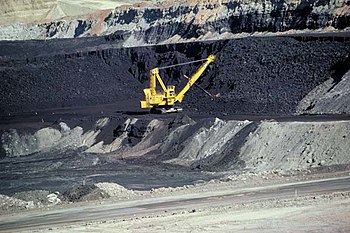


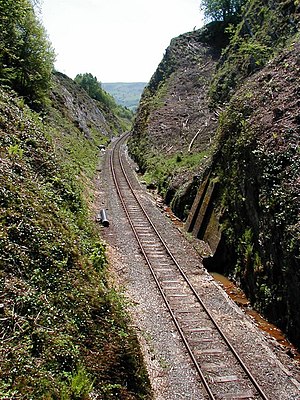

Most of the Earth's rocky surface is composed of sediments.
Def. a "relatively loose sandstone, or porous carbonate rock, impregnated with bitumen"[9] is called oil sand.
Def. a solid, or mostly solid, "form of asphalt from the Uintah Basin of Utah"[10] is called gilsonite.
Road cuts are often the best available views of rock strata. On the lower left is a rock cut along Washington State Highway 155 near Banks Lake. In the center is a rock cut for a railroad through the Cambrian Mountains, Wales.
Another opportunity to view subsurface rock strata is provided by river or stream rock cuts, as in the image on the lowest right.
Magnetometric surveys[edit | edit source]



"A detailed airborne magnetometric survey [such as by the helicopters center and on the left] indicated the structure of the area was followed by a west northwest striking domal feature and the lithologies are probably siliceous, clastic sediments. The southern margin of the antiform has been transected by a west northwest striking shear, whilst the western part of the dome has undergone a later stage folding regime and the intrusion of a granitoid. [Broken Hill Type Ag-Pb-Zn (BHT) mineralisation] BHT mineralisation is predominantly hosted at a major stratigraphic break, and remobilised or offset into both the hangingwall and footwall."[11]
Magnetometric surveys readily detect magnetic iron minerals in red or black bands within banded iron formations such as in the image on the right.
Electromagnetic surveys[edit | edit source]



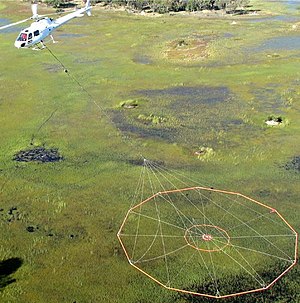
"Airborne electromagnetic surveys using a grounded electric dipole source and magnetic surveys were conducted to delineate resistivity and magnetization structures".[12]
"Airborne Electromagnetic (AEM) data [such as collected by the TEMPEST system shown on the right, the transient electromagnetic (TEM) SkyTEM system shown on the left, or the Versatile Time Domain Electromagnetics (VTEM) system in the center] are one form of the geophysical data acquired by Geoscience Australia. The data are gathered by transmitting an electromagnetic signal from a system attached to a plane or helicopter. The signal induces eddy currents in the ground which are detected by receiver coils towed below and behind the aircraft in a device called a bird. Depending on the system used and the subsurface conditions, AEM techniques can detect variations in the conductivity of the ground to a depth of several hundred metres, [sometimes up to 2000 metres in particularly favourable conditions]. The conductivity response in the ground is commonly caused by the presence of electrically conductive materials such as salt or saline water, graphite, clays and sulfide minerals."[13]
"Since 2006, Geoscience Australia and its State and Territory partners have been collecting AEM data over large areas at broad line spacing (1000-6000 metres) to more fully survey Australia. AEM surveys also require complex processing to allow interpretation and, therefore, are usually designed to detect particular subsurface targets which are based on a perceived conductivity contrast, for example:
- the spatial extent of geological features, such as a clay-rich unit in a sedimentary sequence or a graphite-bearing unit in a metamorphic complex
- the depth of an unconformity between sedimentary cover and the underlying basement rock
- the location of groundwater resources, such as fresh or saline aquifers."[13]
Conductivity surveys[edit | edit source]

Conductivity measurements of the distribution of electrical conductivity in the ground is made aerially with a sensor suspended from the helicopter such as in the image on the right map changes in the ground water.
Hyperspectral imaging systems[edit | edit source]

"[Airborne Real-time Cueing Hyperspectral Enhanced Reconnaissance (ARCHER)] is essentially something used by the geosciences. It's pretty sophisticated stuff … beyond what the human eye can generally see."[14]
"It might see boulders, it might see trees, it might see mountains, sagebrush, whatever, but it goes 'not that' or 'yes, that'. The amazing part of this is that it can see as little as 10 per cent of the target, and extrapolate from there."[14]
Ground-penetrating radar[edit | edit source]

"The ability of a sophisticated radar instrument to image large regions of the world from space, using different frequencies that can penetrate dry sand cover, produced the discovery in this image: a previously unknown branch of an ancient river, buried under thousands of years of windblown sand in a region of the Sahara Desert in North Africa. This area is near the Kufra Oasis in southeast Libya, centered at 23.3 degrees north latitude, 22.9 degrees east longitude. The image was acquired by the Spaceborne Imaging Radar-C/X-band Synthetic Aperture (SIR- C/X-SAR) imaging radar when it flew aboard the space shuttle Endeavour on its 60th orbit on October 4, 1994. This SIR-C image reveals a system of old, now inactive stream valleys, called "paleodrainage systems.""[15]
Aerial gravity gradiometry[edit | edit source]

The aircraft imaged on the right carried-out aerial high-resolution gravity gradiometry system in combination with LIDAR digital terrain mapping, electromagnetics, digital video, and gamma-ray spectrometry over "onshore areas along the South-Eastern Tanzanian Coastal Basin and the eastern arm of the East African Rift."[16]
Aerial induced polarization[edit | edit source]

The airplane imaged on the right is equipped with an induced polarization/resistivity device for use in time and frequency modes. Induced polarization is a reliable technique for detecting disseminated sulphides associated with base metal and gold deposits.
Aerial magnetotellurics[edit | edit source]


"Magnetotellurics (MT) is an electromagnetic method of imaging the earth's subsurface [conducted both aerially portrayed in the image on the left and through ground contact]. It uses natural variations in the earth's magnetic field to map contrasts in the electrical resistivity of the subsurface. These data [as in the image on the right] are used to image changes in the electrical resistivity over a large range of depths: from the top of the crust to the mantle. Such resistivity models are then interpreted geologically in terms of the fluid, thermal and structural evolution of the lithosphere."[17]
Surface-contact exploration[edit | edit source]


Geoseismology of an area of interest can be accomplished with the installation for a temporary seismic station as in the image on the right or left.
Reflection seismology[edit | edit source]

For reflection seismology, a charge is detonated (the shoot) into the ground. The sound travels through the Earth below and reflects off rock layers between the shoot location and the receiver line spread of geophones shown on the right.
Refraction seismology[edit | edit source]


In the refraction seismogram (center) of the North Sea continental shelves, sand ridges near the base form the first prolific elongated reservoir bodies that are parallel to the Dutch coast. Landward is to the right. Basinward is to the left.
"Sand ridges form the first prolific elongated reservoir bodies that are formed parallel to the Dutch coast [...]. The bodies are being capped by a distinct [maximum flooding surface (MFS)] that fills the adjoining regions of elongated sand ridges with muds and claystone—forming a stratigraphic trap."[18]
Electrical resistivity tomography[edit | edit source]

"Electric current flows in earth materials at shallow depths through two main methods. They are electronic conduction and electrolytic conduction. In electronic conduction, the current flow is via free electrons, such as in metals. In electrolytic conduction, the current flow is via the movement of ions in groundwater. In environmental and engineering surveys, electrolytic conduction is probably the more common mechanism. Electronic conduction is important when conductive minerals are present, such metal sulfides and graphite in mineral surveys."[19]
"Igneous and metamorphic rocks typically have high resistivity values. The resistivity of these rocks is greatly dependent on the degree of fracturing, and the percentage of the fractures filled with ground water. Thus a given rock type can have a large range of resistivity, from about 1000 to 10 million Ω⋅m, depending on whether it is wet or dry. This characteristic is useful in the detection of fracture zones and other weathering features, such as in engineering and groundwater surveys."[19]
"Sedimentary rocks, which are usually more porous and have higher water content, normally have lower resistivity values compared to igneous and metamorphic rocks. The resistivity values range from 10 to about 10000 Ω⋅m, with most values below 1000 Ω⋅m. The resistivity values are largely dependent on the porosity of the rocks, and the salinity of the contained water."[19]
"Unconsolidated sediments generally have even lower resistivity values than sedimentary rocks, with values ranging from about 10 to less than 1000 Ω⋅m. The resistivity value is dependent on the porosity (assuming all the pores are saturated) as well as the clay content. Clayey soil normally has a lower resistivity value than sandy soil. However, note the overlap in the resistivity values of the different classes of rocks and soils. This is because the resistivity of a particular rock or soil sample depends on a number of factors such as the porosity, the degree of water saturation and the concentration of dissolved salts."[19]
"The resistivity of groundwater varies from 10 to 100 Ω⋅m. depending on the concentration of dissolved salts. Note the low resistivity (about 0.2 Ω⋅m) of seawater due to the relatively high salt content. This makes the resistivity method an ideal technique for mapping the saline and fresh water interface in coastal areas. One simple equation that gives the relationship between the resistivity of a porous rock and the fluid saturation factor is Archie’s Law. It is applicable for certain types of rocks and sediments, particularly those that have a low clay content."[19]
Coastal seabed mapping[edit | edit source]


The ship pictured on the right is currently employed by the Osiris Hydrographic & Geophysical Projects Ltd (Osiris Projects) for coastal seabed mapping and offshore geophysical survey work.
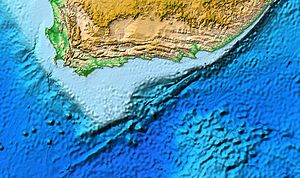
A "multibeam bathymetric mapping cruise [was] conducted aboard the National Oceanic and Atmospheric Administration (NOAA) Ship Nancy Foster [in the image on the right] from June 4 to June 16, 2011. Using echosounders installed on the hull of Nancy Foster, the science team mapped canyons and shelf regions at high resolution over more than 380 square miles (1,000 square kilometers) of seafloor from south of Cape Hatteras, located offshore of North Carolina, to the eastern tip of Long Island in New York."[20]
"Characteristics collected include the size and number of landslides, soil and rock properties, the water depth they occur in, and the style in which they fail."[20]
Marine seismology[edit | edit source]

In marine seismiology one or an array of airguns is used to produce sound waves by releasing air under a pressure of 200 bar about every minute. The waves are reflected by the various sediment and rock layers in the ground. The echo is recorded by a streamer which is some hundred to thousand meters long hose, filled with hundreds of hydrophones in oil, towed by the research vessel.
Mineral exploration[edit | edit source]


Sulfur is often surface mined from volcano deposits, as in the image on the right.
Road cuts are also an opportunity to explore for minerals.
Subsurface exploration[edit | edit source]

In the image on the right, there is a drill tower with drill pipe. Next to the drill tower are tanks for storing recovered fluids.

"A [Virginia Institute of Marine Science] VIMS field crew [assembled in the image on the left] collects sediment cores on the landward side of the Plum Island barrier island in May 2014. These cores were collected with a Geoprobe drill rig [shown] and went as much as 60 feet below the surface of the island. Cores were collected in 4 feet sections and brought back to VIMS for processing."[21]
Directional drillings[edit | edit source]



While directional drilling includes vertical drilling, the term usually refers to angles less than vertical. These occur when what is sought cannot be reached by vertical drilling.
The second image down on the right shows miners within a coal mine shaft drilling at angles above and below horizontal to loosen coal for removal.
The horizontal flushing drill with the machine in the image on the left is a directional drilling technique for horizontal boring. This allows pipelines to be laid underground without having to dig out a trench. The drillings can be several hundred meters long. For the majority of all holes, diameters up to a maximum of 700 mm are sufficient.
Logs[edit | edit source]



Def. the "analysis and recording of the strata penetrated by the drill of an oil well as an aid to exploration"[22] is called well logging.
Mud logging as pictured on the right is the process of recording the lithology a rotary drill penetrates, typically used in oil well drilling.
Mud log on the left shows from left to right: a plot of porosity (blue), a rate of penetration 'ROP' (black), a lithology (gray=shale & yellow=sand), gas hydrocarbons (blue=C4, purple=C3, cyan=C2 and green=total), total gas (black-dot), mud weight (light blue), and acorrected d-Exponent (red-dash).
For reference in the center image of drill cuttings, the sand grain and red shale are approximately 2 mm in diameter.
Sediment cores[edit | edit source]


Sediment cores may be obtained "by drilling or jack-hammering a steel rod or shoving a hand auger or hollow "push core" into a beach or marsh or water bottom, and pulling up sediment samples for analysis."[23]
"You can think of a sediment core as being more or less a tape recorder of time. Within that sediment core, we work with proxies, or environmental proxies, and these can be very simple measures of grain size or composition or some organic geochemical property or maybe pollen."[24]
"There are environments that preserve storm records that are buried in the sea bed, so that you can go down through time and actually develop a record of the intensity and frequency of cyclonic storms. That's something that's pretty high up on the radar for coastal inhabitants. Kind of understanding the pattern of these storms through time helps us to understand what might be coming down the pike."[24]
"You take a sediment core through a barrier island and under that is marsh, bay, marsh, mainland. You have maybe an old forest, roots. Looking back in time at that location, hundreds of thousands of years ago, you get this vertical succession of these different layers."[25]
Ice cores[edit | edit source]

An ice core is a cylindrical sample of a rocky object consisting mostly of water ice. As shown in the image at the right, the long axis is in the direction of the coring into the object from its outer surface.
An ice core is taken with a hollow drill supported by a rig.
Coring[edit | edit source]





"A core is collected by separating it from the surrounding material."[26][26]
A diagram showing the components of a drill is at the right. The coring end of the drill has knives attached as shown in the image at the left. The drill above the knives is a hollow steel tube. The inner tube holds the ice core and the outer tube collects the cuttings or shavings from the action of the knives.
To power and stabilize the drill for coring, a rig such as in the photo at the second left is used.
"The length of the drill barrel determines the maximum length of a core sample [...]. Collection of a long core record [...] requires many cycles of lowering a drill assembly, cutting a core 4–6 m in length, raising the assembly to the surface, emptying the core barrel, and preparing another assembly for drilling."[26]
"Boring ice to depths in excess of about 300 meters requires a fluid with a density closely matched to that of ice to prevent lithostatic pressure from causing plastic collapse of the borehole; the latter frequently results in loss of the drilling equipment. The fluid, or mixture of fluids, must simultaneously satisfy criteria for density, low viscosity, frost resistance, as well as workplace safety and environmental compliance over both the short term (e.g., fire hazard and acute toxicity) and long term (chronic toxicity, local and global environmental degradation). The fluid must also satisfy other criteria, for example those stemming from the analytical methods employed on the ice core."[27]
"A number of different fluids and fluid combinations have been tried in the past. Since GISP2 (1990-1993) the US Polar Program has utilized a single-component fluid system, n-butyl acetate, but the toxicology, flammability, aggressive solvent nature, and longterm liabilities of n-butyl acetate raises serious questions about its continued application."[27]
"The European community, including the Russian program, has concentrated on the use of two-component drilling fluid consisting of low-density hydrocarbon base boosted to the density of ice by addition of halogenated-hydrocarbon (s.l.) densifier. Many of the proven densifier products are now considered too toxic, or are no longer available due to efforts to enforce the Montreal Protocol on ozone-depleting substances."[27]
In April 1998 on the Devon Ice Cap filtered lamp oil was used as a drilling fluid. In the Devon core it was observed that below about 150 m the stratigraphy was obscured by microfractures.[28]"[26]
When the drill barrel is filled, the barrel is removed from the rocky object and maneuvered, oriented, or tilted, as in the third image at the left, so that the ice core may be released, being performed in the image on the lowest left.
Electrical conductivity[edit | edit source]

"Continuous measurements made in the field included dielectric profiling and electrical conductivity (related to the concentrations of neutral salts and acid)."[29]
Core processing[edit | edit source]

Modern practice is to ensure that cores remain uncontaminated, since they are analysed for trace quantities of chemicals and isotopes. They are sealed in plastic bags after drilling and analysed in clean rooms.
The core is carefully extruded from the barrel; often facilities are designed to accommodate the entire length of the core on a horizontal surface. Drilling fluid will be cleaned off before the core is cut into 1-2 meter sections. Various measurements may be taken during preliminary core processing.
Current practices to avoid contamination of ice include:
- Keeping ice well below the freezing point.
- At Greenland and Antarctic sites, temperature is maintained by having storage and work areas under the snow/ice surface.
- At GISP2, cores were never allowed to rise above -15 °C, partly to prevent microcracks from forming and allowing present-day air to contaminate the fossil air trapped in the ice fabric, and partly to inhibit recrystallization of the ice structure.
- Wearing special clean suits over cold weather clothing.
- Mittens or gloves.
- Filtered respirators.
- Plastic bags, often polyethylene, around ice cores. Some drill barrels include a liner.
- Proper cleaning of tools and laboratory equipment.
- Use of laminar-flow bench to isolate core from room particulates.
For shipping, cores are packed in styrofoam boxes protected by shock absorbing bubble-wrap.
Due to the many types of analysis done on core samples, sections of the core are scheduled for specific uses. After the core is ready for further analysis, each section is cut as required for tests. Some testing is done on site, other study will be done later, and a significant fraction of each core segment is reserved for archival storage for future needs.
Projects have used different core-processing strategies. Some projects have only done studies of physical properties in the field, while others have done significantly more study in the field. These differences are reflected in the core processing facilities.
Neutrons[edit | edit source]
Neutrons interact with the protons of hydrogen gas and monatomic hydrogen. This interaction and its measurement allows an estimate to be made of rock or sediment porosity. Standardized to water, the neutron absorption by oil and/or water allows a normalized porosity.
Gamma-rays[edit | edit source]

A number of naturally occurring radioactive isotopes emit gamma rays. Well corings can be scanned with Geiger counters to track gamma-ray emissions with depth.
In the well log on the right two different radioactive isotope intensities blue and red lines versus depth indicate the measured gamma rays. The blue trace shows increasing intensity to the right. The red trace shows increasing intensity to the left. Sand section of interest is located at th bottom of log where the traces both decrease in intensity indicating reduced gamma-ray radioactivity. The red line is the well-bore caliper which would indicate well-bore wash out.
Likely naturally gamma-ray emitting isotopes include potassium : Gamma ray energy 1.46 MeV, thorium series: Gamma ray energy 2.61 MeV and Uranium-Radium series: Gamma ray energy 1.76 MeV.
X-rays[edit | edit source]


"Beginning in 1995, a large outlet glacier of the Sermersauq Ice Cap on Disko Island [Greenland] surged 10.5 km downvalley to within 10 km of the head of the fjord, Kuannersuit Sulluat, reaching its maximum extent in summer 1999 before beginning to retreat. Sediment discharge to the fjord increased from 13 x 103 t day-1 in 1997 to 38 x 103 t day-1 in 1999. CTD results, sediment traps and cores from the 2000 melt season document the impact of the surge on the glacimarine environment of the fjord."[30]
"Short gravity cores were taken and CTD profiles were recorded at stations throughout Kuannersuit Sulluat [...]. Positions located by GPS are accurate to ±10 m or less. The stream flowing over the sandur to the head of the fjord was gauged and integrated suspended sediment samples were recovered from primary channels."[30]
"The cores were photographed, X-rayed and logged. X-radiographs provided measures of the number and size of gravel particles interpreted as ice-rafted debris (IRD) and the grey-scale (GS) of the scanned images was plotted as a measure of the properties of the sand and silt."[30]
"The twelve layers in core D4 [imaged at the right] suggest a mean period of about 20 days for these events based on the accumulation rates in the traps [...]. In general, these layers have both higher MS and X-radiographs have lighter toned GS, the former related to lower water content and the latter also related to greater absorption of X-rays by the larger rock and mineral fragments."[30]
There "are notable differences in the surge-generated sediments. The proximal sediments [such as in core D4 at the right] are more clearly laminated and layered in visual examination of the cores and as seen in the X-radiographs [compared to distal sediments as imaged on the left for core D20]. These consist both of the subtle differences in the fine-grained sediments on a millimetre scale, and of the sand layers up to 8 cm thick representing more energetic processes (Ó Cofaigh and Dowdeswell, 2001). Both are a response to greater sediment input to the fjord."[30]
Rock densities[edit | edit source]

Geophysical anomalies and crustal faulting in the Puget Lowland, shows Everett, Tacoma, and Seattle Basins. Bouger gravity anomaly data combined with seismic reflection traveltime data was used model rock density at 5 km depth. Blue is the softer, less dense sedimentary deposits, red is the harder, more dense mafic basalt of the Crescent Formation, other colors are intermediate. Black lines are shoreline of Puget Sound, Hood Canal, and the Strait of Juan de Fuca. White dashed lines are crustal faults; faults east of Tacoma Basin are conjectural.
Excavations[edit | edit source]
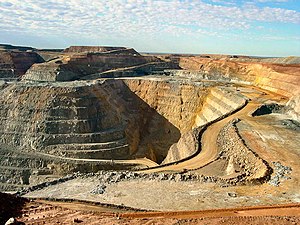
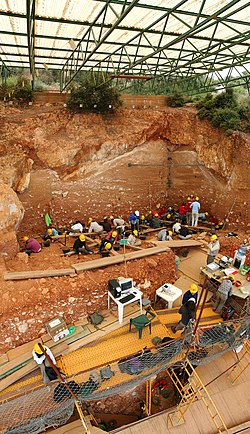
"Archaeological field survey is the method by which archaeologists (often landscape archaeologists) search for archaeological sites and collect information about the location, distribution and organization of past human cultures across a large area (e.g. typically in excess of one hectare, and often in excess of many km2)."[31]
Surveys are conducted "to search for particular archaeological sites or kinds of sites, to detect patterns in the distribution of material culture over regions, to make generalizations or test hypotheses about past cultures, and to assess the risks that development projects will have adverse impacts on archaeological heritage.[32]"[31]
"The surveys may be: (a) intrusive or non-intrusive, depending on the needs of the survey team (and the risk of destroying archaeological evidence if intrusive methods are used) and; (b) extensive or intensive, depending on the types of research questions being asked of the landscape in question. Surveys can be a practical way to decide whether or not to carry out an excavation (as a way of recording the basic details of a possible site), but may also be ends in themselves, as they produce important information about past human activities in a regional context."[31]
"[E]xcavation is the exposure, processing and recording of archaeological remains. An excavation site or "dig" is a site being studied."[33]
Gasifications[edit | edit source]

"Underground Coal Gasification (UCG) involves igniting coal in the ground, then collecting and using the gases that result from its partial combustion. Although the idea dates back over a century, very few UCG plants have ever been built. Underground gasification could potentially allow the use of coal that is currently uneconomical to mine. Underground gasification eliminates the need for strip mining and transportation of coal, as well as potentially making carbon capture and sequestration more practical. However, UCG produces large amounts of CO2, and the coal combustion wastes that are left behind can leach pollutants into nearby groundwater, and have caused major contamination in UCG pilot projects."[34]
"The form of UCG used in most modern projects consists of drilling two wells into a coal seam. Air or oxygen is injected into one well and a controlled combustion reaction is started in the seam itself - a more-controlled version of a natural coal seam fire. Gases are collected through the second well and are separated in a facility at the surface. This process produces primarily hydrogen and CO2, with lesser amounts of carbon monoxide, methane, and trace amounts of other gases."[34]
"These gases are then burned to produce energy, as in a natural gas plant. Hydrogen is the primary energy-containing gas in the mix. The combination of carbon monoxide and hydrogen is called syngas and can be combusted directly to produce heat or can be liquefied and refined in processes similar to that described for coal-to-liquids. Although CO2 is one of the major products of UCG, it is simply a waste product and does not contain any recoverable energy. Because the combustion occurs underground, it heats the surrounding rock. This portion of the heat is not accessible for industrial use, therefore UCG burns more coal (per unit energy produced) than would be required if it was first mined. However, conventional mining and transport of coal also requires significant energy and have associated releases of greenhouse gases."[34]
Vertical pits[edit | edit source]


Snow pits are usually shallow vertical pits to assess annual snow accumulation (image on the left) or to obtain a vertical cross-section for a specific location. On the right, a glaciologist measures perennial snow depth, depth and thickness of firn and depth to glacial ice (blue ice).
Mining[edit | edit source]


The diagram on the right shows a model for vertical shaft mining. On the left are abandoned winding towers used in vertical shaft mining.
See also[edit | edit source]
References[edit | edit source]
- ↑ Muhammad moolla (15 May 2009). "Topic:Mining, In: Wikiversity". San Francisco, California: Wikimedia Foundation, Inc. Retrieved 2016-05-05.
{{cite web}}:|author=has generic name (help) - ↑ Robert Simmon; Marit Jentoft-Nilsen (October 2, 2010). "The Water Planet". Washington, DC USA: NASA. Retrieved 2013-05-29.
- ↑ Paula G. Coble "Marine Optical Biogeochemistry: The Chemistry of Ocean Color" Chemical Reviews, 2007, volume 107, pp 402–418. doi: 10.1021/cr050350
- ↑ "petroleum, In: Wiktionary". San Francisco, California: Wikimedia Foundation, Inc. 16 July 2014. Retrieved 2015-01-09.
- ↑ "tar, In: Wiktionary". San Francisco, California: Wikimedia Foundation, Inc. 5 January 2015. Retrieved 2015-01-09.
- ↑ "pitch, In: Wiktionary". San Francisco, California: Wikimedia Foundation, Inc. 12 December 2014. Retrieved 2015-01-10.
- ↑ "asphalt, In: Wiktionary". San Francisco, California: Wikimedia Foundation, Inc. 20 October 2014. Retrieved 2015-01-09.
- ↑ "amber, In: Wiktionary". San Francisco, California: Wikimedia Foundation, Inc. 19 December 2014. Retrieved 2015-01-09.
- ↑ SemperBlotto (11 May 2006). "oil sand, In: Wiktionary". San Francisco, California: Wikimedia Foundation, Inc. Retrieved 2017-10-01.
{{cite web}}:|author=has generic name (help) - ↑ Paul in Saudi (5 August 2004). "gilsonite, In: Wiktionary". San Francisco, California: Wikimedia Foundation, Inc. Retrieved 2017-10-01.
{{cite web}}:|author=has generic name (help) - ↑ Malcolm Castle (3 October 2007). INDEPENDENT GEOLOGIST’S REPORT ON THE MINERAL PROJECTS in WESTERN AUSTRALIA. South Perth, WA: Agricola Mining Consultants Pty Ltd. pp. 24. http://www.aspectfinancial.com.au/asxdata/20071030/pdf/00776801.pdf. Retrieved 2017-10-01.
- ↑ Kenji Okazaki; Toru Mogi; Mitsuru Utsugi; Yoshihiko Ito; Hideki Kunishima; Takashi Yamazaki; Yukitsugu Takahashi; Takeshi Hashimoto et al. (May 2011). "Airborne electromagnetic and magnetic surveys for long tunnel construction design". Physics and Chemistry of the Earth 36 (5): 1237–1246. doi:10.1016/j.pce.2011.05.008. https://www.researchgate.net/profile/Hisatoshi_Ito/publication/251679640_Airborne_electromagnetic_and_magnetic_surveys_for_long_tunnel_construction_design/links/54adbd030cf2213c5fe418bb.pdf. Retrieved 2017-10-01.
- ↑ 13.0 13.1 R. Brodie; M. Sambridge; A. Fisher (May 2012). "Airborne Electromagnetics". Symonston ACT: Commonwealth of Australia (Geoscience Australia). Retrieved 2017-10-02.
- ↑ 14.0 14.1 Cynthia Ryan (6 September 2007). "High-tech computer joins Fossett search". Web Citation. Retrieved 2017-10-02.
- ↑ Porao (4 October 1994). "File:Kufra-space-radar.jpg, In: Wikimedia Commons". San Francisco, California: Wikimedia Foundation, Inc. Retrieved 2016-09-27.
{{cite web}}:|author=has generic name (help) - ↑ Mozambique Resources Post (23 July 2015). "Africa Oil & Gas: TPDC awards CGG airborne gravity gradiometer surveys onshore Tanzania". Tanzania: Mozambique Resources Post. Retrieved 2017-10-02.
- ↑ Laszlo Katona (2014). "Gawler Craton Airborne Survey community information". South Australia: Geoscience Australia. Retrieved 2017-10-05.
- ↑ Farrukh Qayyum; Nanne Hemstra; Raman Singh (07 October 2013). "A modern approach to build 3D sequence stratigraphic framework". Oil & Gas Journal 111 (10): 10. http://www.ogj.com/articles/print/volume-111/issue-10/exploration-development/a-modern-approach-to-build-3d-sequence-stratigraphic.html. Retrieved 2017-10-05.
- ↑ 19.0 19.1 19.2 19.3 19.4 M.H. Loke (2004). "Tutorial: 2-D and 3-D electrical imaging surveys" (PDF). Alberta, Canada: University of Alberta. Retrieved 2017-10-03.
- ↑ 20.0 20.1 Jason Chaytor; Daniel Brothers (16 November 2011). "High-Resolution Sonar Mapping of Mid-Atlantic Canyons to Assess Tsunami Hazards". USGS/NOAA. Retrieved 2017-10-03.
- ↑ Joe Fudge (31 December 2014). "Pictures: VIMS studies sediment core samples". Virginia: DailyPress. Retrieved 2015-01-12.
- ↑ SemperBlotto (24 July 2015). "well logging, In: Wiktionary". San Francisco, California: Wikimedia Foundation, Inc. Retrieved 2016-05-05.
{{cite web}}:|author=has generic name (help) - ↑ Tamara Dietrich (1 January 2015). "VIMS geologists use sediment cores as a window to the past". DailyPress. Retrieved 2015-01-12.
- ↑ 24.0 24.1 Steve Kuehl (1 January 2015). "VIMS geologists use sediment cores as a window to the past". DailyPress. Retrieved 2015-01-12.
- ↑ Christopher Hein (1 January 2015). "VIMS geologists use sediment cores as a window to the past". DailyPress. Retrieved 2015-01-12.
- ↑ 26.0 26.1 26.2 26.3 "Ice core, In: Wikipedia". San Francisco, California: Wikimedia Foundation, Inc. 5 September 2009. Retrieved 2014-08-24.
- ↑ 27.0 27.1 27.2 M. Gerasimoff (2003). "Drilling Fluid Observations and Recommendations for U.S. Polar Program, WAISCORES Drilling Project". University of Wisconsin-Madison: Ice Coring and Drilling Services. Retrieved 2014-10-07.
- ↑ "History of Glacier Investigations in Canada" (PDF). Retrieved October 14, 2005.
- ↑ B. Stauffer (1992). "The GRIP Ice Coring Effort". Washington, DC USA: NOAA. Retrieved 2014-08-24.
- ↑ 30.0 30.1 30.2 30.3 30.4 Robert Gilbert; Niels Nielsen; Henrik Möller; Joseph R. Desloges; Morten Rasch (2002). "Glacimarine sedimentation in Kangerdluk (Disko Fjord), West Greenland, in response to a surging glacier". Marine Geology 191: 1-18. http://geog.queensu.ca/gilbert/surge%20paper.PDF. Retrieved 2014-09-24.
- ↑ 31.0 31.1 31.2 "Archaeological field survey, In: Wikipedia". San Francisco, California: Wikimedia Foundation, Inc. October 12, 2012. Retrieved 2013-01-13.
- ↑ E. B. Banning (2002). Archaeological Survey. New York: Kluwer Academic Press.
- ↑ "Excavation (archaeology), In: Wikipedia". San Francisco, California: Wikimedia Foundation, Inc. January 8, 2013. Retrieved 2013-01-13.
- ↑ 34.0 34.1 34.2 David Coil; Erin McKittrick; Bretwood Higman; Ground Truth Trekking (3 October 2014). "Underground Coal Gasification (UCG)". Ground Truth Trekking. Retrieved 2015-01-11.
 KSF
KSF